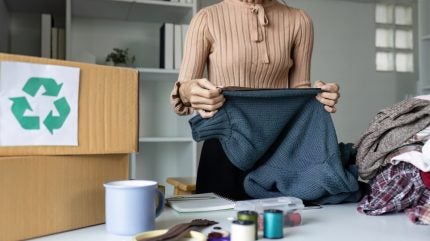Making fashion sustainability profitable remains huge opportunity

MAKING FASHION SUSTAINABILITY PROFITABLE REMAINS HUGE OPPORTUNITY
Fashion
brands, retailers and manufacturers must learn how to turn sustainability and
ESG policy into profit in order to fulfil fashion consumption's projected 63%
growth by 2030.
A
new report suggests the fashion, textile and apparel industry’s biggest
challenge over the next few years is accelerating progress on a closed loop and
regenerative system – but it also dubs it the sector’s “biggest commercial
opportunity”.
Commercialising
fashion sustainability
The report titled ‘Policy to Profit: How New Rules Create Commercial Wins for
Fashion‘ and published by B Corp boutique marketing
firm Grounded points out the financial benefits of climate-related
opportunities seen by the world’s largest companies have more than doubled
since 2020. These firms now average over $3bn each, which equates to the
world’s largest business seeing $5tn in potential gains.
It asserts “the ultimate business plan to
save the world is attainable” as the United Nations Development Program says
over $4tn is needed to close the world’s financing gap for achieving
Sustainable Development Goals.
The report says there are three key things
across three phases that will drive business and commercial strategy:
- Design/manufacture phase:
Minimise the use of finite and fossil fuel-based resources. Re-design,
innovate and scale around renewable, recycled or bio derived inputs
instead
- Use phase: Keep
feedstock, textiles, garments and apparel in use for longer – whether
through more sustainable textile marketplaces, such as World Collective,
or through repair and re-commerce, such as Thredup
- Recovery phase: Close the
loop through recovery, collection, recycling, re-manufacturing or
refurbishment.
The report describes the recovery phase as
the most challenging aspect to circularity. It says: “The last yard of closing
the loop requires industry-wide transparency, reverse logistics,
infrastructure, investment and easily accessible consumer collection points and
behaviour change.”
Partnership and collaboration will also be
critical as working with organisations across the fashion supply chain can help
keep the ambition loop going. It also provides a game-plan for how to better
integrate policies and regulation into a commercial, brand and innovation
pipeline.
Plus, there is a new wave of ESG policy and
legislation that fashion brands, retailers and manufacturers will need to
comply with to avoid falling behind.
Key ESG
policies and certifications impacting the fashion industry
Grounded explains the new and incoming ESG
policies that are coming through mainly from the EU and California aim to hold
businesses accountable for their impact and contribution to environmental
issues such as carbon emissions, water usage, chemical pollution and waste
management.
The key ESG policies and certifications are:
- EU’s Corporate
Sustainability Reporting Directive (CSRD)
- EU’s Corporate
Sustainability Due Diligence Directive (CSDDD)
- California’s Climate
Corporate Data Accountability Act (SB 253)
- EU’s Directive on
Empowering Consumers for the Green Transition (EmpCo) and Proposed Green
Claims Directive
- EU’s Ecodesign for
Sustainable Products Regulation
- California’s Responsible
Textile Recovery Act of 2024 – SB 707
- California PFAS
Prohibitions
- EU Forced Labour
Regulation
- US Uyghur Forced Labor
Prevention Act
Key
recommendations for turning fashion sustainability into profit
The report lists some “failsafe”
considerations and drivers of governance, environmental stewardship and
commercial innovation, but highlights its AI bot Gaia can also provide more
specific recommendations to individual brands and retailers on request.
- Mitigating risk
- Evaluate the policies to
check what’s required with a legal counsel
- Educate across
departments on ESG policy requirements
- Understand where the
brand does business
- Evaluate corporate
structures and supply chain connections
- PFAS – consider that you
may need to prepare for elimination and secure testing services
- Know the high-risk
materials and where they are in the supply chain
- Document all
public-facing statements concerning ESG.
2. Taking the first steps
- Think ahead about how to
support future ESG initiatives
- Support all ESG claims
with third-party accreditations and certifications
- Stay alert to new
policies that are being discussed
- Perform a landscape
assessment to identify potential paradigm shifts
Creating a fashion flywheel of
impact
Grounded suggests building out an
insight-driven framework that enables any brand, business, social enterprise or
non-profit to identify the biggest opportunity for triple bottom line impact at
a corporate, culture, category, brand or community level.
The report concludes: “Your sustainability
value proposition (SVP) that can drive both commercial and cultural innovation
is at the centre of the flywheel – at the intersection between purpose, people
(which is the biggest intention gaps for all key stakeholders) and then the
planet (the biggest environmental, social or governance based risk and
opportunity that you face.
“Hopefully, this is a good starting point to
prompt discussion and illustrate how your business can start to take the
necessary steps to create your own flywheel of impact to help accelerate better
design, use and re-use across the industry.
“The flywheel of impact can be run as a
cross-functional workshop in just one day.”
